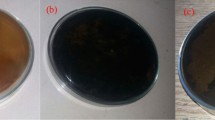Abstract
Melanins are complex natural pigments that darken the skin and are difficult to degrade. This study evaluated synthetic melanin decolorization by the crude laccase from fungus Lentinus polychrous in the absence and presence of selected redox mediators. The greatest melanin decolorization activity was 87 % at pH 6.5 within 3 h in the presence of 2,2-azinobis (3-ethylbenzothiazoline-6-sulfonate) diammonium salt (ABTS), whereas only about 22 % melanin decolorized at pH 5.0 in case of no mediator. The optimum temperatures for melanin decolorization in the absence and presence of ABTS were 55 and 35°C, respectively. Using a natural redox mediator, 1.0 mmol/L vanillin leads to 45 % melanin decolorization. Our results suggest the possibility of applying vanillin for L. polychrous laccase-catalyzed decolorization of melanin.





Similar content being viewed by others
References
Boissy RE, Visscher M, De Long MA (2005) DeoxyArbutin: a novel reversible tyrosinase inhibitor with effective in vivo skin lightening potency. Exp Dermatol 14:601–608. doi:10.1111/j.0906-6705.2005.00337.x
Bradford MM (1976) A rapid and sensitive method for quantitation of microgram quantities of protein utilizing the principle of protein-dye binding. Anal Biochem 72:248–254. doi:10.1006/abio.1976.9999
Butler MJ, Day AW (1998) Destruction of fungal melanins by ligninases of Phanerochaete chrysosporium and other white rot fungi. Int J Plant Sci 159(6):989–995. doi:10.1086/297619
Butler MJ, Gardiner RB, Day AW (2005) Degradation of melanin or inhibition of its synthesis: are these a significant approach as a biological control of phytopathogenic fungi? Biol Control 32:326–336. doi:10.1016/j.biocontrol.2004.08.008
Camarero S, Ibarra D, Martínez MJ, Martínez AT (2005) Lignin-derived compounds as efficient laccase mediators for decolorization of different types of recalcitrant dyes. Appl Environ Microbiol 71:1775–1784. doi:10.1128/AEM.71.4.1775-1784.2005
Chhabra M, Mishra S, Sreekrishnan TR (2008) Mediator-assisted decolorization and detoxification of textile dyes/dye mixture by Cyathus bulleri laccase. Appl Biochem Biotechnol 151:587–598. doi:10.1007/s12010-008-8234-z
Clancy CMR, Simon JD (2001) Ultrastructural organization of eumelanin from Sepia officinalis measured by atomic force microscopy. Biochemistry 40:13353–13360. doi:10.1021/bi010786t
Kaneko S, Cheng M, Murai H, Takenaka S, Murakami S, Aoki K (2009) Purification and characterization of an extracellular laccase from Phlebia radiata strain BP-11-2 that decolorizes fungal melanin. Biosci Biotechnol Biochem 73:939–942. doi:10.1271/bbb.80740
Khammuang S, Sarnthima R (2009) Mediator-assisted Rhodamine B decolorization by Tramates versicolor laccase. Pak J Biol Sci 12:616–623. doi:10.3923/pjbs.2009.616.623
Kim YJ, Uyama H (2005) Tyrosinase inhibitors from natural and synthetic sources: structure, inhibition mechanism and perspective for the future. Cell Mol Life Sci 62:1707–1723. doi:10.1007/s00018-005-5054-y
Kogej T, Gorbushina AA, Gunde-Cimerman N (2006) Hypersaline conditions induce changes in cell-wall melanization and colony structure in a halophilic and a xerophilic black yeast species of the genus Trimmatostroma. Mycol Res 110:713–724. doi:10.1016/j.mycres.2006.01.014
Kogej T, Stein M, Volkmann M, Gorbushina AA, Galinski EA, Gunde-Cimerman N (2007) Osmotic adaptation of the halophilic fungus Hortaea werneckii: role of osmolytes and melanization. Microbiology 153:4261–4273. doi:10.1099/mic.0.2007/010751-0
Lin WP, Lai HL, Liu YL, Chiung YM, Shiau CY, Han JM, Yang CM, Liu YT (2005) Effect of melanin produced by a recombinant Escherichia coli on antibacterial activity of antibiotics. J Microbiol Immunol Infect 38:320–326
Liu GY, Nizet V (2009) Color me bad: microbial pigments as virulence factors. Trends Microbiol 17:406–413. doi:10.1016/j.tim.2009.06.006
Mohorčič M, Friedrich J, Renimel I, Andre P, Mandin D, Chaumont JP (2007) Production of melanin bleaching enzyme of fungal origin and its application in cosmetics. Biotechnol Bioprocess Eng 12:200–206
Morozova OV, Shumakovich GP, Shleev SV, Yaropolov YI (2007) Laccase-mediator systems and their applications: a review. Appl Biochem Microbiol 43:523–535. doi:10.1134/S0003683807050055
Murugesan K, Nam IH, Kim YM, Chang YS (2007) Decolorization of reactive dyes by a thermostable laccase produced by Ganoderma lucidum in solid state culture. Enzyme Microb Technol 40(7):1662–1672. doi:10.1016/j.enzmictec.2006.08.028
Nakasaki K, Kumazawa M, Murakami S, Takenaka S, Koike K, Aoki A (2008) Purification, characterization, and gene cloning of Ceriporiopsis sp. strain MD-1 peroxidases that decolorize human hair melanin. Appl Environ Microbiol 74:5106–5112
Rättö M, Chatani M, Ritschkoff AC, Viikari L (2001) Screening of micro-organisms for decolorization of melanins produced by bluestain fungi. Appl Microbiol Biotechnol 55:210–213
Rendon MI, Gaviria JI (2005) Review of skin lightening agents. Dermatol Surg 31:886–889. doi:10.1111/j.1524-4725.2005.31736
Rodríguez-Couto S (2011) Production of laccase and decolouration of the textile dye Remazol Brilliant Blue R in temporary immersion bioreactors. J Hazard Mater 194:297–302. doi:10.1016/j.jhazmat.2011.07.098
Sarnthima R, Khammuang S, Svasti J (2009) Extracellular ligninolytic enzymes by Lentinus polychrous Lév. under solid-state fermentation of potential agro-industrial wastes and their effectiveness in decolorization of synthetic dyes. Biotechnol Bioprocess Eng 14:513–522. doi:10.1007/s12257-008-0262-6
Satar R, Husain Q (2009) Use of bitter gourd (Momordica charantia) peroxidase together with redox mediators to decolorize disperse dyes. Biotechnol Bioprocess Eng 14:213–219. doi:10.1007/s12257-008-0175-4
Terao M, Tomita K, Oki T, Tabe L, Gianni M, Garattini E (1992) Inhibition of melanogenesis by BMY-28565, a novel compound depressing tyrosinase activity in B16 melanoma cells. Biochem Pharmacol 43:183–189
Woo SH, Cho JS, Lee BS, Kim EK (2004) Decolorization of melanin by lignin peroxidase from Phanerochaete chrysosporium. Biotechnol Bioprocess Eng 9:256–260. doi:10.1007/BF02942340
Acknowledgments
This work was financially supported by Mahasarakham University (fiscal year 2009). The authors thank P. Suwannawong for the laboratory assistance and thank Center of Excellence for Innovation in Chemistry (PERCH-CIC), Office of the Higher Education Commission, Ministry of Education and Department of Chemistry, Faculty of Science, Mahasarakham University for the partial supports.
Author information
Authors and Affiliations
Corresponding authors
Rights and permissions
About this article
Cite this article
Khammuang, S., Sarnthima, R. Decolorization of synthetic melanins by crude laccases of Lentinus polychrous Lév.. Folia Microbiol 58, 1–7 (2013). https://doi.org/10.1007/s12223-012-0151-4
Received:
Accepted:
Published:
Issue Date:
DOI: https://doi.org/10.1007/s12223-012-0151-4




